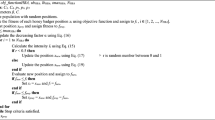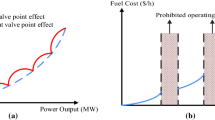Abstract
In recent years, big data and cloud technology have been widely used in information extraction and optimization decision. An improved artificial bees colony (ABC) algorithm called QABC is proposed for optimum design of the reusable launch vehicle (RLV) reentry trajectory. Because of poor convergence property of classical ABC algorithm in solving constrained nonlinear optimization problems (CNOPs), several modifications are carried out in this paper. The modifications include a quantum delta potential well model, two dynamic tolerance mechanisms, and a general generation mechanism of selection probability which is associated with the fitness of food source. In this paper, taking RLV three-dimension reentry trajectory design as an application example, a single-objective/multi-constraints optimization model was established with physical programming (PP) method and static penalty function method, in which four objectives (maximum range, minimum heat load, minimum heat flux (MHF), minimum oscillation) and five constraints (dynamic pressure, overload, heat flow, terminal altitude, and terminal velocity) were taken into account. Four single objective trajectory designs and two typical multi-objective trajectory designs with different preference structures were resolved, and the results showed that the optimization model founded by PP method was effective and flexible to reflect the designers preference. The improved algorithm, QABC, show excellent performance in solving RLV reentry trajectory optimization problem and a good prospect in other engineering applications.
Similar content being viewed by others
References
Alam MS (2010) Self-adaptation of mutation step size in artificial bee colony algorithm for continuous function optimization. In: Computer and Information Technology (ICCIT), 2010 13th International Conference on IEEE, Islam, MM, pp 69–74
Betts JT (1998) Survey of numerical methods for trajectory optimization. J Guid Control Dyn 21(2):193–207
Dingni Z, Yi L (2011) Rlv reentry trajectory optimization through hybridization of an improved ga and a sqp algorithm
Enmi Y (2008) Trajectory optimization of hypersonic gliding reentry vehicle based on the physical programming [j]. Acta Aeronautica Et Astronautica Sinica 5:002
Gang C, Min X, Zi-Ming W, Si-lu C (2005) Rlv reentry trajectory multi-objective optimization design based on nsga-ii algorithm. In: Atmospheric Flight Mechanics Conference and Exhibit. AIAA, San Francisco
Gao WF, Liu SY (2011) Hybrid artificial bee colony algorithm. J Syst Eng Electron 33(5):1167–1170
Goldberg DE, Deb K (1991) A comparative analysis of selection schemes used in genetic algorithms. Foundations of Genetic Algorithms 1:69–93
Hamida SB, Schoenauer M (2002) Aschea: new results using adaptive segregational constraint handling. In: Proceedings of the 2002 Congress on Evolutionary Computation, 2002. CEC’02. IEEE, vol 1, pp 884–889
Hull DG (1997) Conversion of optimal control problems into parameter optimization problems. J Guid Control Dyn 20(1):57–60
Karaboga D (2005) An idea based on honey bee swarm for numerical optimization. Tech. rep., Technical report-tr06, Erciyes University, Engineering Faculty, Computer Engineering Department
Karaboga D, Akay B (2009) A comparative study of artificial bee colony algorithm. Appl Math Comput 214(1):108–132
Karaboga D, Basturk B (2007a) Artificial bee colony (abc) optimization algorithm for solving constrained optimization problems. Foundations of fuzzy logic and soft computing. Springer, pp 789–798
Karaboga D, Basturk B (2007b) A powerful and efficient algorithm for numerical function optimization: artificial bee colony (abc) algorithm. J Glob Optim 39(3):459–471
Karaboga D, Basturk B (2008) On the performance of artificial bee colony (abc) algorithm. Appl Soft Comput 8(1):687–697
Karaboga D, Gorkemli B (2011) A combinatorial artificial bee colony algorithm for traveling salesman problem. In: 2011 International symposium on innovations in intelligent systems and applications (INISTA). IEEE, pp 50–53
Kovach J (2008) Development of an experiment-based robust design paradigm for multiple quality characteristics using physical programming. Int J Adv Manuf Technol 35(11-12):1100–1112
Lee WP (2011) A novel artificial bee colony algorithm with diversity strategy. In: 2011 7th International Conference on Natural Computation (ICNC). IEEE, vol 3, pp 1441–1444
Li J, Tao F (2015) Big data in product lifecycle management. Int J Adv Manuf Technol 81:667–684
Messac A (1996) Physical programming-effective optimization for computational design. AIAA journal 34 (1):149–158
Mezura-Montes E (2010) Smart flight and dynamic tolerances in the artificial bee colony for constrained optimization. In: 2010 IEEE Congress on Evolutionary Computation (CEC). IEEE. Cetina-Domíngez, O, pp 1–8
Ozturk C, Karaboga D (2011) Hybrid artificial bee colony algorithm for neural network training. In: 2011 IEEE Congress on Evolutionary Computation (CEC). IEEE, pp 84–88
Qingzhen Z, Chen G (2008) Reentry trajectory planning optimization based on sequential quadratic programming.. In: 2nd International Symposium on Systems and Control in Aerospace and Astronautics. ISSCAA 2008. IEEE, Zhang, R, pp 1–5
Sun J, Feng B, Xu W (2004) Particle swarm optimization with particles having quantum behavior
Takahama T, Sakai S (2006) Constrained optimization by the ε constrained differential evolution with gradient-based mutation, and feasible elites. In: IEEE Congress on Evolutionary Computation, 2006. CEC 2006. IEEE, pp 1–8
Tang Y, Chen S, Xu M (2011) Reentry trajectory planning based on genetic optimization of terminal matching. In: 2011 International Conference on Electronic and Mechanical Engineering and Information Technology (EMEIT). IEEE, vol 3, pp 1151–1155
Tao F, Zhang L (2010a) A quantum multi-agent evolutionary algorithm for selection of partners in a virtual enterprise, vol 59, Nee, A, pp 485–488
Tao F, Zhao D, Yefa H, Zhou Z (2010) Correlation-aware resource service composition and optimal-selection in manufacturing grid. Eur J Oper Res 201(1):129–143
Tao F, Zhang L, Venkatesh V, Luo Y, Cheng Y (2011) Cloud manufacturing: a computing and service-oriented manufacturing model. Proc Inst Mech Eng B J Eng Manuf 225(10):1969– 1976
Tao F, LaiLi Y, Xu L, Zhang L (2013) Fc-paco-rm: a parallel method for service composition optimal-selection in cloud manufacturing system. In: IEEE Transactions on Industrial Informatics, vol 9, pp 2023–2033
Tao F, Cheng Y, Da Xu L, Zhang L, Li BH (2014a) Cciot-cmfg: cloud computing and internet of things-based cloud manufacturing service system, vol 10, pp 1435–1442
Tao F, Feng Y, Zhang L (2014b) Clps-ga: a case library and pareto solution-based hybrid genetic algorithm for energy-aware cloud service scheduling. Appl Soft Comput 19:264–279
Tao F, Laili Y, Liu Y, Feng Y, Wang Q, Zhang L, Xu L (2014) Concept, principle and application of dynamic configuration for intelligent algorithms. Syst J, IEEE 8(1):28–42
Tao F, Zuo Y, Da Xu L, Zhang L (2014). IEEE Trans Ind Inf 10(2):1547–1557
Tao F, Cheng Y, Zhang L, Nee A (2015a) Advanced manufacturing systems: socialization characteristics and trends, pp 1–16
Tao F, Li C, Liao T, Laili Y (2015b) Bgm-bla: a new algorithm for dynamic migration of virtual machines in cloud computing
Tao F, Zhang L, Liu Y, Cheng Y, Wang L, Xu X (2015c) Manufacturing service management in cloud manufacturing: overview and future research directions. Journal of Manufacturing Science and Engineering-Transaction of the ASME 137(4). 040,912–1–040,912–11
Tessema B, Yen GG (2006) A self adaptive penalty function based algorithm for constrained optimization. In: IEEE Congress on Evolutionary Computation, 2006. CEC 2006. IEEE, pp 246–253
Tu L H, Yuan J P (2006) Reentry skipping trajectory optimization using direct parameter optimization method. In: 14th AIAA/AHI Space Planes and Hypersonic Systems and Technologies Conference. Luo JJ, p 7993
Wang Y, Cai Z (2007) Multiobjective optimization and hybrid evolutionary algorithm to solve constrained optimization problems. IEEE Trans Syst Man Cybern B Cybern 37(3):560–575
Wang Y, Cai Z (2008) An adaptive tradeoff model for constrained evolutionary optimization. IEEE Trans Evol Comput 12(1):80– 92
Xie F, Wang Y (2009) Constrained trajectory optimization using migrant particle swarm optimization algorithm. In: 4th International conference on bio-inspired computing, 2009. BIC-TA’09. IEEE. Zhang, D, pp 1–7
Yin J, Meng H (2011) Artificial bee colony algorithm with chaotic differential evolution search. Jisuanji Gongcheng yu Yingyong(Computer Engineering and Applications) 47(29):27–30
Zhang B, Guan S, Chen S (2011) Modified ant colony algorithm-based reentry trajectory optimization for suborbital launch vehicle. Journal of Astronautics 32(6):1244–1248
Zhong Y, Lin J, Ning J, Lin X (2011). In: 2011 Seventh international conference on natural computation (ICNC). IEEE, vol 2. Hybrid artificial bee colony algorithm with chemotaxis behavior of bacterial foraging optimization algorithm, pp 1171–1174
Zou X, Tao F, Jiang P, Gu S, Qiao K, Zuo Y, Xu L (2015) A new approach for data processing in supply chain network based on fpga, pp 1–12
Author information
Authors and Affiliations
Corresponding author
Rights and permissions
About this article
Cite this article
Kang, Y., Cheng, L., Zhang, Q. et al. Data-driven RLV multi-objective reentry trajectory optimization based on new QABC algorithm. Int J Adv Manuf Technol 84, 453–471 (2016). https://doi.org/10.1007/s00170-015-8124-9
Received:
Accepted:
Published:
Issue Date:
DOI: https://doi.org/10.1007/s00170-015-8124-9




